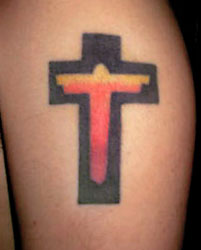
Cross Tattoo Gallery

"My Cross Tattoo" by Jason Gennaro
|
This tattoo needs little explanation - it's a design of Christ dying on the cross. This was my first religious tattoo. The design was taken from a pendant that my parents gave me when I celebrated my confirmation. In the pendant, the Christ figure is open space, cut from the silver. In the tattoo, the space is filled with the colours of a setting or rising sun - a visual allusion to Christ's descending to the dead and rising to new life. This tattoo was done by Psycho Dave at Way Cool Tattoos - Downtown in Toronto. This tattoo is on my left arm. Jason
Gennaro's web site devoted to Judeo-Christian body art |
Cross Tattoo's
- Click on image to view larger photo -
Tattoo by Hoss, L.L.C.
http://www.tattoosbyhoss.com/
A Brief Tattoo History
Written by Jason Gennaro
|
We know that almost all cultures throughout history have subscribed to some form of body art or body manipulation, and for many, this included tattoos. Very briefly, here is some information on tattooing in Pre-Biblical, Biblical, and Post-Biblical time periods. As well, I have included links to some other tattoo history resources. Pre-Biblical Over the last 150 years, archaeologists have unearthed several mummified remains marked with tattoos: In 1991, the frozen, well-preserved body of a Siberian "Iceman" was discovered in the Alps. More than 5,000 years old, the body had 57 tattoos.1 In 1948, a Russian archaeologist who was excavating a group of tombs found the mummy of a Scythian Chieftain. On the mummy's right arm, there were tattoos of a donkey, a mountain ram, and two deer. As well, there were tattoos of four running rams that encircled his shin.2 In 1891, archaeologists discovered the mummified remains of an Egyptian priestess named Amunet, who likely lived some time between 2160 BC and 1994 BC. Her body had tattoos on its arms, legs, and below the belly button.3 In Japan, scientists have discovered clay figurines - more than 3,000 years old - painted with markings that resemble tattoos.4 Biblical During the time of the Old Testament, much of the pagan world was practicing the art of tattooing as a means of deity worship. This, of course, necessitated a negative response from Israel, which attempted to separate itself from the adoration of false gods: "You shall not make any cuttings in
your flesh Biblical scholar M. W. Thomson suggests, however, that Moses favored tattoos. Thomson speculates that Moses introduced tattoos as a way to commemorate the deliverance of the Jews from slavery in Egypt. In his 1859 study, Thomson suggests that Moses believed the prohibition above applied only to heathen, pagan images.5 Just before the birth of Christ, Roman writers such as Virgil, Seneca, and Galenus reported that many slaves and criminals were tattooed.6 Post Biblical Early in the fourth century, when Constantine became Roman Emperor and rescinded the prohibition on Christianity, he also banned tattooing on face, which was common for convicts, soldiers, and gladiators. Constantine believed that the human face was a representation of the image of God and should not be disfigured or defiled.7 It is documented that a monk who lived in the late fifth century had a tattoo on his thigh that read: "Manim, the disciple of Jesus Christ."8 Procopius of Caesarea, who lived during the first half of the sixth century and wrote number of official histories, once reported that many Christians were tattooed, on their arms, with a cross or the name of Christ.5 Charles MacQuarrie, in his work, "Insular Celtic Tattooing: History, Myth, and Metaphor, "details how "marks" that are mentioned in the Life of Saint Brigit may have been tattoos. He also suggests that Celtic Christians approved of some, but not all, tattoos.8 At the council of Calcuth in Northumberland, the 786 Report of the Papal Legates mentioned two types of tattooing: one of pagan superstition, which does not aid any Christian, and another for the sake of God, which provides certain (unnamed) rewards.8 Crusaders, arriving in the Holy Land, often tattooed a small cross on their hands or arms as a sign that they desired a Christian burial.9
Sources 1. http://www.pbs.org/wgbh/nova/transcripts/2518iceman.html
Tattoo History Resources American Museum of Natural History University of Pennsylvania Museum of Archeology and
Anthropology Australian Museum
The History of Body Modification Around the World |
Art Gallery Subject Gallery Subject Gallery 2 Home
| Credits: My Cross Tattoo description & photograph by Jason Gennaro. Used by permission of Jason Gennaro; image & text may not be reproduced without permission. http://www.religioustattoos.net/ Cross & Sunrise, Cross & Rose and Crucifix Tattoo's by Hoss, L.L.C. Photos used by permission of Hoss, L.L.C.; may not be reproduced without permission. Tattoos by Hoss, L.L.C. - http://www.tattoosbyhoss.com/ SGT Que's tattoo photograph by Eric Shindelbower. A Brief Tattoo History written by Jason Gennaro. Used by permission of Jason Gennaro; may not be reproduced without prior written permission. Jason's web site - http://www.relioustattoos.net/ |